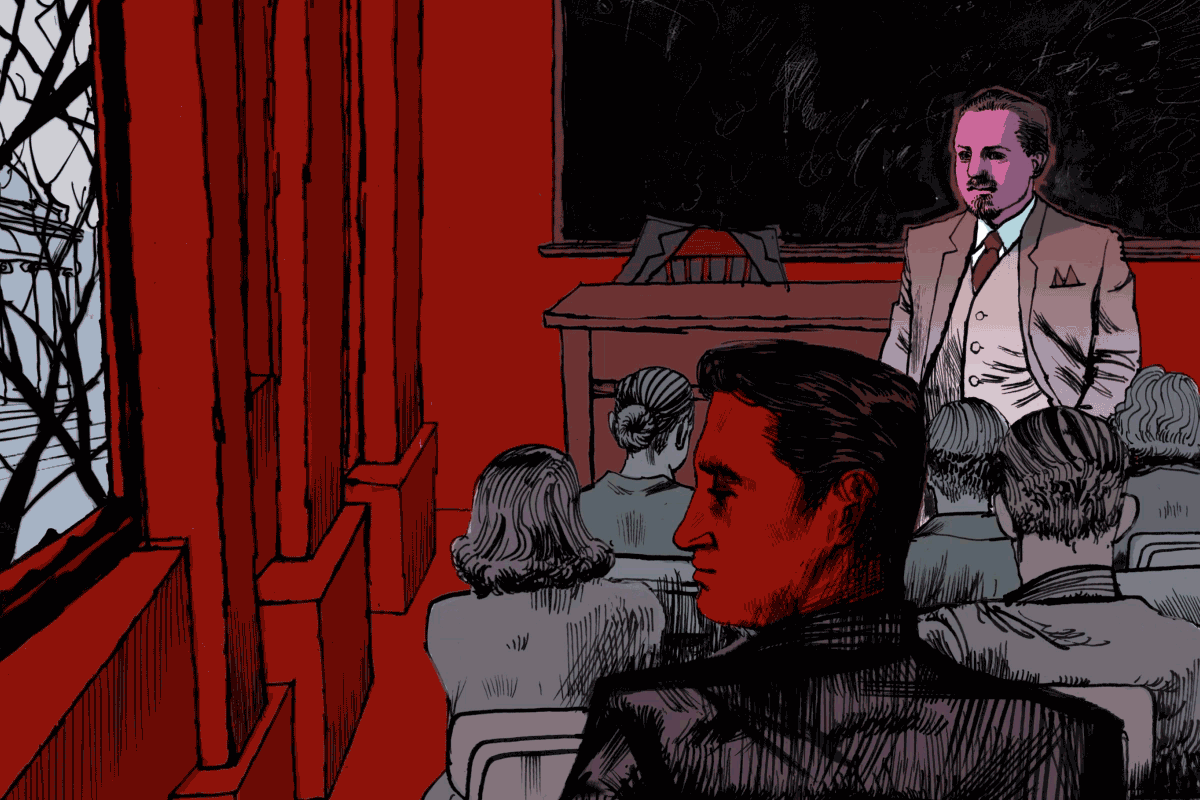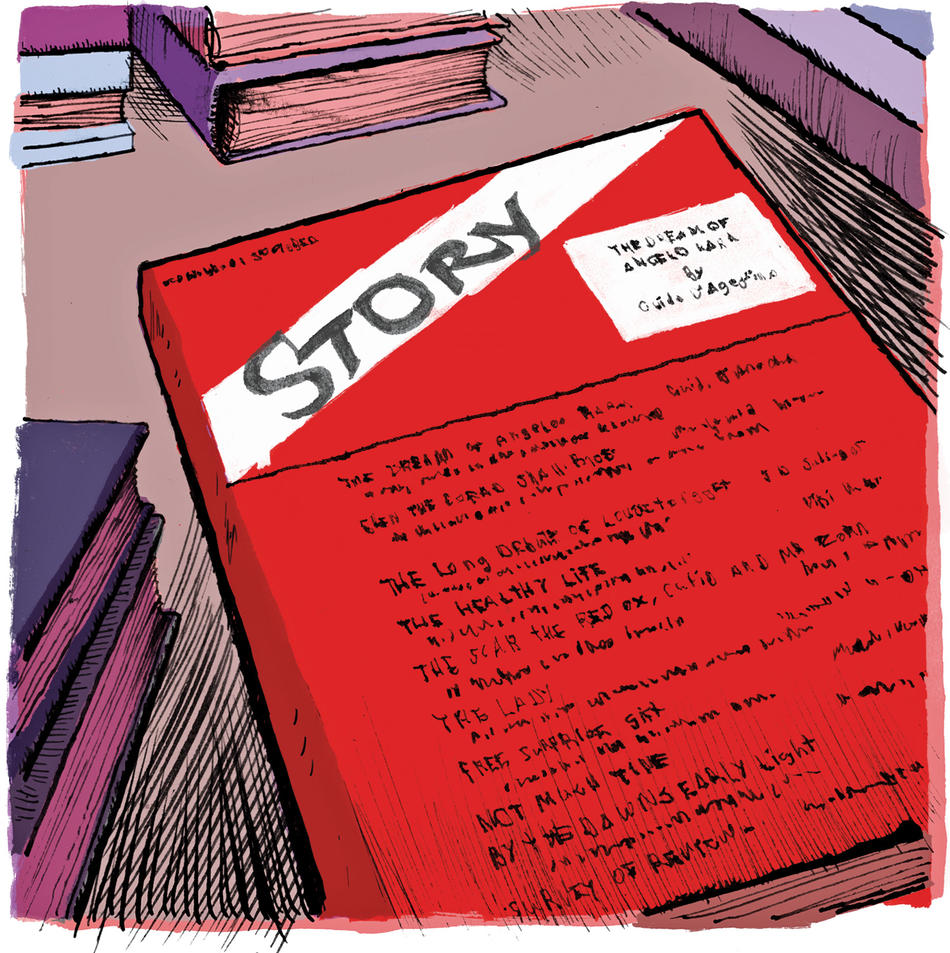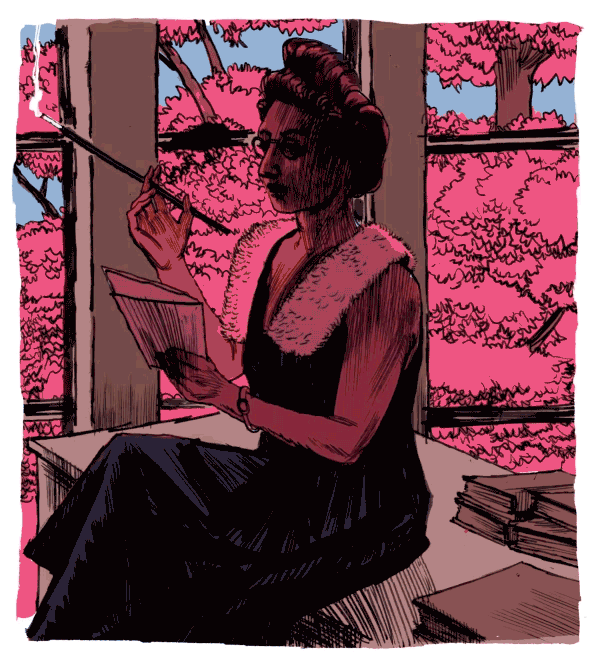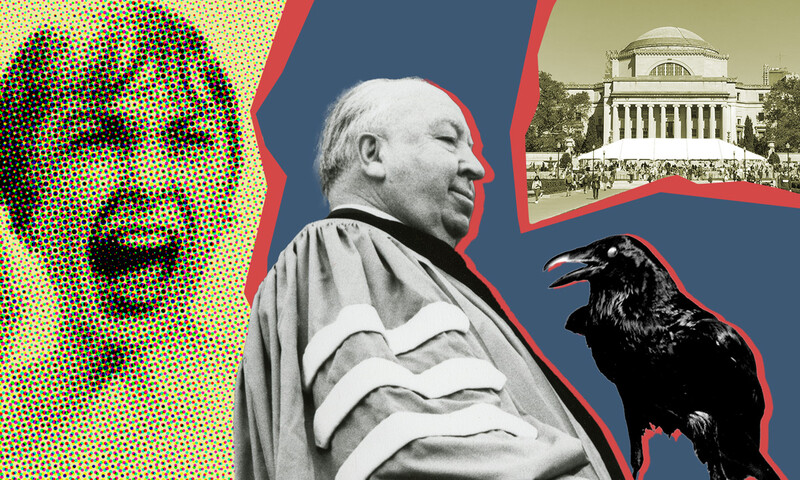The Teachers Who Inspired J.D. Salinger and a Generation of American Writers

On a Monday evening in the spring of 1939, Whit Burnett, a lanky thirty-nine-year-old writing teacher, walked into room 505 in what is now Dodge Hall carrying a volume by Faulkner. His students were already seated and eager to begin. Burnett, a writer and editor who’d been teaching this course for two years, often read aloud to his class. He knew Bill Faulkner, having published a few of his stories.
Burnett had never set out to be an educator, but with writing courses popping up around the country, working professionals like him were in high demand. The Iowa Writers’ Workshop, the country’s first creative-writing program, had been founded just three years earlier, and while Columbia was decades away from establishing its own graduate writing program, it offered classes in short fiction and poetry through University Extension, soon to be the School of General Studies. Columbia’s course in short-story writing was one of the oldest in the country, dating to 1911.
Burnett was something of a hot ticket on the academic circuit. In 1931, he and his wife, Martha Foley, had founded Story magazine, which they still ran, and their acumen for spotting new talent had made their hundred-page monthly a must-read for the big New York publishers. In its first few years, Story had featured debut works by William Saroyan, Nelson Algren, Conrad Aiken, Kay Boyle, John Cheever, Wallace Stegner, and Carson McCullers — an eye-popping list that would soon include Norman Mailer, Jean Stafford, Richard Wright, Joseph Heller ’50GSAS, Truman Capote, and Tennessee Williams.
But little did Burnett know, in the spring of 1939, that the writer who would become Story’s most fabled discovery was seated in the back row of room 505.
He was twenty years old, tall and dark-eyed, a Park Avenue kid who had flunked out of NYU and Pennsylvania’s Ursinus College. His name was Jerry, and he was by all accounts a disappointment to his father, a prosperous Manhattan meat-and-cheese importer. Many of Burnett’s students would have crawled over broken glass to get into Story, but Jerry, slouching in a haze of cigarette smoke, gave no such hints. When Burnett talked about what made a good story, or read aloud from one, or decried “bunk” in fiction and praised honesty, Jerry would just sit there, staring out the window, with its view of the Low Library dome. He didn’t seem to be listening, and, strangest of all, he didn’t hand in a single story.
But Jerome David Salinger wanted to be a writer — in fact, he was a writer, albeit an unpublished one with rejection slips from all the best magazines.
“There’s no question that the young Salinger had literary ambitions,” says Thomas Beller ’92SOA, author of the biographical memoir J. D. Salinger: The Escape Artist. “But in the space of this opportunity to impress his teacher, he whiffs. No, it’s worse than that: he doesn’t even take a swing.”
Salinger, having produced exactly nothing in the spring of ’39, signed up again for Burnett’s class in the fall. Beller thinks Burnett’s unaffected manner appealed to the pretense-averse Salinger. “Burnett was an entrepreneur, a badass, an editor, and he did the class for the same reasons anyone would: it felt good to have some affiliation with Columbia, and the money wasn’t bad.” He was not, in other words, overly invested. “His demeanor in the classroom was: ‘This is what I am. This is what I do. I’ll try to be useful to you, and if you get something out of it, great, but I’m not going to kill myself if you don’t,’” says Beller. “I think that was liberating to Salinger.”
Midway through the fall semester, Salinger wrote a letter to his teacher to apologize for his anemic showing. “It was very self-lacerating,” says Beller, who visited the Story archive at Princeton to review Salinger’s letters. (In 1987, a federal appeals-court decision in Salinger v. Random House, Inc., upheld Salinger’s right to keep his personal correspondence private, and the letter has not been published.) “This letter, to me, is the Big Bang of Salinger’s career. It’s not unusual for a student to say to a professor, aloud, ‘I let you down.’ What’s unusual in this case is that it took the form of a very elaborate and articulate letter which contained Freudian language about complexes and the ego, saying how he’s been all tangled up and he’s sorry and he’s going to do better.
“Then, immediately after this cathartic confession, Jerry Salinger cracks open like an egg, and J. D. Salinger comes out. He bursts forth with three stories, bang-bang-bang, and hands them to Burnett.”
Whit Burnett and Martha Foley met in 1925, on the copy desk at the San Francisco Journal. Foley, who would have her own colorful teaching career at Columbia, was born in Boston in 1897. A barricade-pushing suffragist and socialist, she dropped out of Boston University to be a writer. To make a living, she turned to newspapers, stepping bravely into the hostile stag environment of 1920s newsrooms. Burnett was a reporter and editor, and Foley later recalled their meeting: “A blond young man on the other side of the desk looked at me and I looked back at him. The Smart Set, then edited by Mencken and Nathan, was mentioned. He wrote short stories for it. I told him what I thought of Mencken. He told me what he thought of Mencken. We didn’t agree about Mencken at all.”
Burnett — laconic, introverted, not prone to laughter, and no socialist — was her opposite. But he, too, dreamed of literary laurels. They fell in love and moved to New York, where they worked on the big dailies, and in 1927 they sailed for Paris, getting jobs at the Herald Tribune. It was the Jazz Age Paris of Ernest Hemingway and Gertrude Stein and Sylvia Beach, owner of Shakespeare and Company bookstore. Foley met everyone. She loved the city, but when Burnett got a better-paying job in Vienna, she followed him. In the Austrian capital they worked as correspondents for the New York Sun, mingled at the Café Louvre, and wrote and submitted fiction. Then Edward O’Brien, editor of the annual Best American Short Stories anthology, sent Burnett a letter saying that one of his stories had been selected for the 1930 edition. Foley was ecstatic: Whit would now get his stories published everywhere! But her optimism was doused by the realization that there were, after all, only a small number of literary magazines. Even the “slicks” — popular magazines like the Saturday Evening Post, Collier’s, and the Ladies’ Home Journal that were printed on glossy paper, unlike the “pulps” — were cutting back on fiction. That’s when Foley got an idea: what if she and Burnett started their own magazine — one devoted solely to the short story?
No such beast existed, and Burnett was skeptical. They had neither the money nor the equipment to print the thing. But there was a mimeograph machine at the foreign correspondents’ club in town that could handle a small print run. Burnett came around. Using their own stories and those written by friends, Foley and Burnett produced 167 copies of Story for the inaugural edition in April 1931. They also had a son that fruitful year — David Burnett ’52CC.
Though Story paid just twenty-five dollars for a manuscript at a time when the slicks were paying F. Scott Fitzgerald $4,000, the Story in-basket was overflowing. In the magazine’s first two years, eleven of its titles were collected in Best American Short Stories. That feat drew the attention of Bennett Cerf 1919CC, 1920JRN cofounder of Random House. Cerf and his partners, seeing Story as a gold mine for new talent, put up money and brought the magazine to the company’s building on East 57th Street. Within a few years, Burnett and Foley would both be teaching at Columbia.
One of the stories that Jerry Salinger handed in to Whit Burnett in the fall of 1939 was “The Young Folks.” Set in a house filled with college kids, cigarettes, and Daddy’s Scotch, it captures in a simple, dialogue-driven narrative the stumbling longing of swing-era youth. The Salinger fizz — the hard-boiled wit, the knowing observation, the Fitzgeraldian vividness — is in first bloom, as are the rhythms of the idiomatic, accented chitchat that Salinger practically invented. Burnett liked “The Young Folks” and paid Salinger twenty-five dollars to publish it in the March/April 1940 issue of Story.
There can be few moments in a writer’s life comparable to getting that first bite from a publisher. Salinger was supercharged. He wrote a shrewdly triumphal letter to Burnett, which the New York Times quoted in 1988:
“I’m twenty one, New York born, and I can draw a rejection slip with both hands tied behind me,” the letter said. “Writing has been important to me since I was seventeen. I could show you a lot of nice faces I’ve stepped on to illustrate the point. Now that you’ve accepted the story I’ll tell everyone to waste no pity on the unpublished short story writer, that his ego can cope with people and circumstance, that he is his own worst enemy. Oh, I’ll be wisdom itself.”
In 1941, Salinger sold “Slight Rebellion Off Madison” to the New Yorker. But the story, which introduced a character named Holden Morrissey Caulfield, wouldn’t come out until five years later, after the war. By then, Salinger was no longer the same man. Drafted in 1942 and shipped to Europe in January 1944, he was part of the D-day landing and was among the first Americans to enter the just-liberated concentration camps of Dachau. Afterward he checked himself into the hospital for what would now be called PTSD. But through all this he kept writing. He published stories in Collier’s and the Saturday Evening Post, and he sent more than sixty letters to Whit Burnett. In 1944, Story ran Salinger’s “Once a Week Won’t Kill You,” for which Salinger, in his author’s bio, wrote, “I’m twenty-five, was born in New York, am now in Germany with the Army … Studied and wrote short stories in Whit Burnett’s group at Columbia. He published my first piece in his magazine, story. Been writing ever since, hitting some of the bigger magazines, most of the little ones. Am still writing whenever I can find the time and an unoccupied foxhole.”
In a letter dated April 14, 1944, Burnett offered to publish a collection of Salinger’s stories with Story’s eight-year-old book-publishing offshoot, Story Press. Salinger was overjoyed. But by the time he returned home in 1946, things had changed. Story Press’s partners, the deeper-pocketed Lippincott Company, had nixed the book idea, and it was Burnett’s unhappy task to break the news to Salinger. The young writer did not take it well.
“He could not seem to get it through his head that it wasn’t Burnett’s fault,” says Beller. “Soon after that, Salinger published ‘A Perfect Day for Bananafish’ in the New Yorker.” In that story, Seymour Glass, a thirty-one-year-old combat veteran and former child genius (he entered Columbia at age fifteen), is vacationing in Florida. After playing in the ocean with a four-year-old girl, Seymour returns to his hotel room, takes out a pistol, and shoots himself in the head.
“With that story, everything that came before in Salinger’s career was essentially excommunicated,” says Beller. “He renounced all the stories he was ready to publish with Burnett and Lippincott so that the official record of his career would begin with these bombshell stories in the New Yorker. ‘Perfect Day’ was a huge deal. ‘Uncle Wiggily in Connecticut’ was a huge deal. When a Salinger story came out in the New Yorker it was like Beyoncé dropping a single. And then, in 1951, came The Catcher in the Rye. Meanwhile, Whit Burnett was on the wrong side of this divide.”
For Martha Foley, Burnett’s most significant student was not Salinger. It was Hallie Southgate Abbett, whose story “Eighteenth Summer” appeared in the March/April 1941 issue. Abbett and Burnett became romantically involved, which prompted a quick and painful divorce. Burnett then married Abbett, who became his editing partner on Story.
It was a brutal blow for Foley, but 1941 also brought other changes. Edward O’Brien died in London, and Foley was called upon to finish editing the year’s Best American Short Stories. It was a job she did assiduously and lovingly for the next thirty-seven years. In her role as “the Saint Peter guarding the gates to a short story writer’s heaven,” as she once called O’Brien, she would help shape and reshape American fiction, showcasing newcomers like Saul Bellow, Bernard Malamud ’42GSAS, Flannery O’Connor, Delmore Schwartz, Eudora Welty ’82HON, Stanley Elkin, Thomas Pynchon, Joyce Carol Oates, Donald Barthelme, and many more.
In 1945, Foley began teaching her own workshop at Columbia (Burnett’s class ended in 1943). Among Foley’s students was Truman Capote, who, in his unfinished novel Answered Prayers, has the narrator describe meeting his wife “at Columbia University, where I had enrolled in a creative-writing class taught by Martha Foley, one of the founder/editors of the old magazine Story.” The actor Anthony Perkins took the class. So did Barbara Probst Solomon ’60GS, who wrote her first novel, The Beat of Life, in Foley’s workshop. Foley was “absolutely incredible with her 1920s lorgnette and cigarette holder,” Probst Solomon told an interviewer in 2009. “Carson [McCullers] had been her student, and Martha would drag her in to talk to the class. Carson was sort of shy, so she would drag in Tennessee Williams. At some point Arthur Miller wandered in — who could have more riches than that?”
The Texas writer John Graves ’48GSAS, author of the memoir Goodbye to a River, once said that he modeled his own teaching on Foley’s. “She didn’t really teach much. She just talked, and we had to turn in one thousand words a week.” Manuscripts were placed anonymously in a folder in the library, and students had to read them before the next session. Sometimes the author could be identified through the prose. There were “a lot of antipathies in those classes,” Graves said, “but it was highly stimulating.”
Foley taught her Columbia course until 1966. By then, she had a coeditor for Best American Short Stories: her son. David Burnett had been editor, in Paris, of an expatriate literary journal, New-Story, which introduced James Baldwin and Terry Southern to American audiences, and in 1958 he joined his mother in scouring the printscape for the pick of the year’s crop. One of their selections for 1965 was “The Application” from Transatlantic Review, written by twenty-six-year-old Jay Neugeboren ’59CC.
“Martha read all the stories herself — every short story published in every magazine and literary quarterly,” says Neugeboren, who edited Foley’s posthumous memoir, The Story of Story Magazine. “She read stories every day until her death.”
Neugeboren met Foley in 1974, when he was writer-in-residence at the University of Massachusetts Amherst. He’d heard that Foley was now living in nearby Northampton and that she had fallen upon hard times. David Burnett had died in 1971 from complications following a drug overdose, and Foley, despondent, had nearly drunk herself to death. Heartbroken, with little money and few possessions, she had left New York and found a furnished apartment in western Massachusetts.
Neugeboren called her, and the two became friends. Stories were what kept her going. “She was full of energy, had a good sense of humor, and she lived and breathed short stories,” Neugeboren says. “She loved writers and loved to talk about writers. But she could barely talk about herself and was forever pissed at Whit. I would say bitter. She didn’t talk about it a lot.”
Neugeboren brought his kids to visit — Foley always had chocolates on hand — and invited her to speak to his writing class at UMass. Foley came alive in the classroom, telling stories about Hemingway and Faulkner and Mencken and Joyce and Sherwood Anderson and Dorothy Parker.
“My students were gaga,” Neugeboren says. “Once, I asked Martha to conduct a class. I gave her the students’ stories, and she was well-prepared. She discussed what she liked about the stories, not what the problems were. That was her way. Students loved it. And Martha loved being around young people.”
When Foley died in September 1977, Neugeboren took the lead in settling her affairs, including going through her papers, which were in storage in Mystic, Connecticut. Among the remnants: an unpublished novel, a draft of a book on writing, and lots of material for her unfinished memoir.
The memoir, Neugeboren saw, was a remarkable cultural record, written by an unsung heroine of American letters. Someone had to rescue it, and fate could not have supplied a better steward. Neugeboren meticulously assembled and edited the manuscript and wrote the foreword and afterword. Norton published The Story of Story Magazine in 1980.
“I loved working on the book,” Neugeboren says. “It was like getting a master class in the history of the American short story.”
Whit Burnett continued devoting his energies to Story and appearing at writers’ conferences through the 1950s, but Salinger had not forgiven him for the Lippincott fiasco. Burnett’s intermittent attempts to get in touch with the writer went unanswered. By 1953, Salinger had other concerns. Appalled by the intrusions on his privacy that followed the success of The Catcher in the Rye, he moved his family to a wooded tract in Cornish, New Hampshire, closing himself off from the world and becoming, as the Times wrote, “the literary world’s most famous recluse.”
In 1964, Hallie Burnett wrote to Salinger, asking him to contribute an introduction to a book celebrating thirty-three years of Story magazine. Salinger, in a stunning turn, obliged. There could hardly be a greater testament to Salinger’s affection for his old mentor. But, as biographer Kenneth Slawenski recounts in J. D. Salinger: A Life, Whit rejected the piece, feeling that it was too much about him and the class, and too little about Story.
That would have seemed to be the end of it. Burnett died in 1973 of a heart attack. But two years later, Hallie Burnett brought out a book that she and Whit had been developing called Fiction Writer’s Handbook. Salinger, who had not published anything in a decade, and despite Burnett’s earlier rebuff, permitted the 1964 essay to be used as the book’s epilogue, under the title “A Salute to Whit Burnett.” It began:
“Back in 1939, when I was twenty, I was a student for a time in one of the present editors’ — Whit Burnett’s — short-story course, up at Columbia. A good and instructive and profitable year for me, on all counts, let me briefly say. Mr. Burnett simply and very knowledgeably conducted a short-story course, never mugwumped over one. Whatever personal reasons he may have had for being there, at all, he plainly had no intentions of using fiction, short or long, as a leg up for himself in the academic or quarterly-magazine hierarchies. He usually showed up for class late, praises on him, and contrived to slip out early — I often have my doubts whether any good and conscientious short-story-course conductor can humanly do more. Except that Mr. Burnett did. I have several notions how or why he did, but it seems essential only to say that he had a passion for good short fiction, strong short fiction, that very easily and properly dominated the room.”
J. D. Salinger, who died in 2010, would have turned one hundred in 2019. He left a complicated legacy as a writer, cultural figure, war veteran, and human being, and his centenary will no doubt be an occasion for remembrances and reappraisals.
Thomas Beller finds it fitting that Dodge Hall, the site of Salinger’s early literary breakthrough, became the seat of Columbia’s School of the Arts. The graduate writing program, established in 1967, is headquartered on the fourth floor. Its classes are held one flight down from the spot where Whit Burnett once read William Faulkner and a young man sat gazing out the window, dreaming of stories to come.
This article appears in the print edition of the Winter 2018 issue with the title “Upper West Side Stories.”




